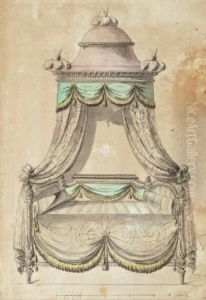Mathieu Liard Paintings
Mathieu Liard was a French painter and engraver born in 1749 in Orléans, France. During the 18th century, he became known for his portrait work, which was highly regarded by his contemporaries. Liard's artistic journey began in his hometown, but he later moved to Paris to further his career in the arts. In Paris, he became a student of the French painter Joseph-Marie Vien, who was a proponent of the neoclassical style that was gaining prominence at the time.
Liard's career spanned a period of significant change in French history, including the French Revolution and the Napoleonic era. Despite the turbulent times, Liard managed to maintain a successful career. His style was characterized by nuanced brushwork and a focus on realistic representation, qualities that made his portraits sought after by the French bourgeoisie and nobility.
Notably, Mathieu Liard exhibited his work at the Salon, the official art exhibition of the Académie des Beaux-Arts in Paris. His participation in the Salon helped to cement his reputation as a skilled portraitist. Liard's engravings also contributed to his fame, as they were widely circulated and showcased his talent for capturing the likeness and character of his subjects.
Liard's life and career were not only marked by his artistic achievements but also by his interactions with other important figures of his time. He was a contemporary of other notable artists and intellectuals with whom he would have interacted in the vibrant cultural scene of Paris.
Mathieu Liard passed away in 1827. While he may not be as well-known as some of his contemporaries today, his works remain a testament to the portrait art of the late 18th and early 19th centuries. Liard's portraits are valuable for their historical significance as well as for their artistic merit, offering insights into the fashions and personalities of the period in which he lived and worked.
